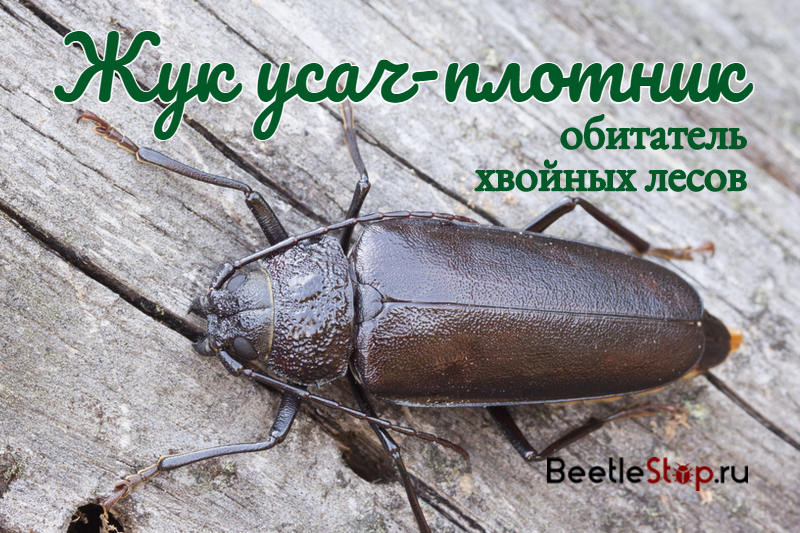Barbel Carpenter - a destroyer of dry pine stumps
Beetles from the family of longhorn beetles or lumberjacks differ in long segmented mustaches, the size of the organ often exceeds the dimensions of the body. 26 thousand species of insects were found all over the world, 583 species live in Russia. Some members of the family are pests of forests and timber. Damage is caused by insect larvae. The barbel carpenter is the largest species of its family in Europe. Red-brown males and black females of the beetle live in coniferous forests. The development of one generation takes 2-4 years. Due to the felling of dry trees, the carpenter barbel population is at risk. The beetle was on the IUCN Red List and the Red Book of the Krasnodar Territory.

Morphological description of the species
The barbel carpenter (Ergatesfaber) belongs to the large family of lumberjacks. Beetles reaching 60 mm are the largest species in Europe and Russia. In insects, sexual dimorphism is clearly manifested. Females are black, integument slightly shiny. The segmented antennae reach the middle of the elytra. On the sides of the head are eyes of a complex faceted type of a notched shape. Pronotum wide, anterior margin elongated. The disc is covered with wrinkled punctures.
Males are reddish-brown in length 30-35 mm. Body flat, pronotum twice as wide as dyne. The edges on the side are finely serrated. The surface is covered with fine punctures, on the sides are two convex shiny areas. Head of medium size, wrinkled. The upper lip is poorly developed, the jaw is more curved than that of a female. Antennae naked, without hairs. Long extend beyond the end of the abdomen. The hard elytra of the male is covered with denser punctures. There are two loosely marked ribs.
Information. In male and female individuals, the structure of the forelimbs, abdomen, elytra is different.
Elytra long, completely hide wings and abdomen. The legs consist of 5 parts, two claws on the foot. The forelimbs are the shortest and the hind limbs the longest. The species is characterized by variability in the structure of the body. In males, shiny spots are differently located, notches on the lateral parts of the pronotum. The forms with a massive head stand out, some insects have thorns in the upper part of the elytra. One option is the furrowed pronotum.
Habitat
Barbel carpenter is common in southern and central parts of Europe, the Mediterranean, Spain, and western Hungary. The beetle lives in the Caucasus, in Turkey, North Africa. The species is found at an altitude of no higher than 1000-1400 m above sea level.
Propagation Features
The summer period of adults is limited to the warm season, they occur from July to September. Beetles additionally eat before mating, feed on pollen, needles, leaves. Barbel is active at dusk and at night. They prefer to live on pines, firs, spruce, sometimes found on alder and poplar. The female lays 150-250 oval yellow eggs under the bark of dry conifers. The masonry is single or in groups, on top it is covered with a special secret.
Offspring development
Larvae develop in dead wood - old stumps, felled trunks. They are found in the root system of trees. Occasionally, the offspring of barbel is in the logs of chopped houses, in fences.Larvae live in rotting wood, process it, contributing to decomposition. The body of the insects is fleshy, soft, yellow-white. They grow to 60-65 mm. The head is drowned in the chest, the jaws are directed forward. On the upper jaw there is a deep notch and a notch on the inside. Around the upper lip are large dark dots.
The head is covered with chitin, the short antennae consist of three segments bent down. On each segment of the body there are spinal corns with two longitudinal grooves. On the abdominal corns, there is one groove and two pits. The larval development period takes 2-4 years; in some cases, it drags on to 12 years. During this time, many moves appear inside the wood, filled with crushed residues.
Information. The larvae of the barbel carpenter larvae can be found not only in thick stumps, but also in thin trunks with a diameter of 5 cm.
Pupa free, all parts of the body distinguishable. Abdomen and pronotum covered with spines. The pupa develops in the cradle. After the exit of the imago, oval holes remain.
Security measures
In the main habitat, the species is represented in large numbers and is not in danger. But in some European countries, the number of beetles has declined. Due to the felling of dead pine and stumps, insects lost their places for the development of offspring. Large specimens of barbel carpenters are popular with collectors, insect collection is prohibited in Hungary.
Representatives of the species Ergatesfaber are protected in Poland, Hungary, Czechoslovakia. In Germany, he was on the list of declining species. The barbel-carpenter is listed in the Red Book of the Krasnodar Territory.


 (votes: 5, average rating: 4,20 out of 5)
(votes: 5, average rating: 4,20 out of 5)